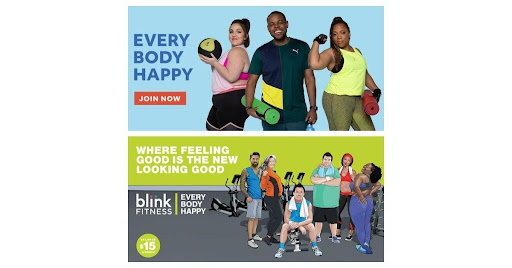A digital ad can be highly effective in attracting audiences and driving conversions; however, marketers must execute it well. Recently, I came across one gym ad and clicked on it instantly to see what it had for me even while I wasn’t initially looking for any gym membership or offers. It piqued my interest, and I wanted to dig deeper into it and find other relevant ads for the same gym.
Here is the ad I am talking about:

The gym “Blink Fitness” created an ad series, “Every Body Happy,” to appeal to everybody regardless of shape and size.
Positive Aspects
Let’s first talk about the positive sides of this digital ad which might make anyone interested in looking into it and knowing more about its offers.
-
Compelling Headline
The ad has a strong, attention-grabbing headline to pique the target audience’s interest immediately. It uses powerful words like “Everybody Happy” and “Where Feeling Good Is the New Looking Good.” It creates a sense of self-importance in the individual, making it difficult for viewers to ignore it.
-
Clear Offer
The ad clearly states a “$15 a month” offer for all members. It creates a sense of value and encourages potential customers to act quickly to take advantage of the offer. It is affordable for many people who want to transform their bodies without spending too much on the gym.
-
Engaging Visuals
The ad uses high-quality images or graphics relevant to the gym, fitness activities, and the target audience. In both pictures, males and females of different sizes and shapes stand or sit in different postures, yet all look confident and happy. So, these visuals help create a connection with the viewer and build interest in the gym and its offerings.
-
Targeted Audience
The ad’s target audience is general, which increases the chances of reaching individuals interested in fitness and gym memberships. It does not specifically target athletes or fitness models. It is for every ordinary person willing to take up the challenge of transforming their body.
-
Includes a Call-to-Action (CTA)
The ad features a CTA, “JOIN NOW,” encouraging viewers to sign up for the lowest possible membership. It also mentions the monthly charges of joining the gym, which are quite low, so an average person can easily afford it.
Negative Aspects
-
Overwhelming Text
The second ad contains too much text or small fonts; it may be difficult for viewers to read and understand the ad’s message. It can deter potential customers from engaging with the content. For instance, $15 is visible, but the font of other text is too small to read.
-
Poor Visuals
The quality of the images could also be better. The low-quality photos look unprofessional and unappealing, diminishing the ad’s effectiveness.
-
Lack of Social Proof:
The ad includes no testimonials, reviews, or endorsements from current members. Potential customers may be skeptical about the gym’s quality and reputation. Some viewers might invest time in the research to know its credibility and authenticity. Still, it won’t be able to grab the attention of those who want to go for the most reputed and high-quality options without any second thoughts.
-
Ineffective Targeting
I found the ad on an unrelated platform or website. This way, the ad might fail to reach the intended audience, resulting in wasted ad spend and low conversion rates.
-
Weak CTA
The CTA should have been better and stronger. Instead of “Join Now,” it might have included something more appealing like “Challenge yourself.” A weak or unclear call-to-action may leave viewers unsure about what action to take, reducing the chances of conversions.
By considering these positive and negative aspects, marketers can design and optimize digital ads to attract and engage their target audience, ultimately driving more campaign conversions and success.
Additional Aspects to Consider to Make a Digital Ad Successful
Here are some additional aspects of a digital ad that marketers should consider to make the ads successful.
Mobile Optimization
In today’s digital age, ensuring the ad is optimized for mobile devices is essential. Positive aspects of mobile optimization include easy-to-read text, fast loading times, and clear call-to-action buttons. So, if marketers fail to optimize ads for mobile, it can lead to poor user experience and lost opportunities for conversion.
Retargeting Strategy
A well-planned retargeting strategy can increase the ad’s effectiveness by displaying it to users who have previously shown interest in the gym or similar services. It can result in higher engagement and conversion rates. On the other hand, if the marketers don’t use retargeting strategy, it may lead to missed opportunities to convert interested users.
Consistency in Branding
Ensuring consistent branding across the ad and the gym’s website or social media profiles helps build trust and credibility with the audience. Inconsistent branding can confuse the viewers and make the ad appear less professional.
Analytics and Performance Tracking
Monitoring the ad’s performance through analytics helps identify which aspects are working well and which need improvement. It enables marketers to optimize the campaign for better results. Marketers not utilizing performance tracking can lead to continued inefficiencies and reduced return on investment (ROI).
A/B Testing
A/B testing different ad variations (such as headlines, images, and CTAs) can help identify which version performs better, allowing marketers to optimize the ad for maximum effectiveness. Ignoring the potential benefits of A/B testing may result in running less effective ads and lower conversion rates.
Seasonality and Timing
Understanding the audience’s preferences and habits can help decide the timing of the ad effectively. For example, promoting discounted gym memberships around New Year’s resolutions or summer beach body goals can lead to higher engagement. However, if the marketers don’t pay attention to this critical aspect, they might end up publishing ads at less relevant times, which will diminish the overall effectiveness.
Localization and Personalization
Tailoring the ad’s content and language to the local audience can create a sense of familiarity and connection, increasing its appeal. Generic or non-localized ads don’t resonate with the target audience and lead to lower engagement.
Ad Placement
The ad’s position on a webpage or within an app can significantly impact its visibility and engagement. Placing the ad above the fold (visible without scrolling) or in a prominent location can help attract more attention. Poor ad placement can lead to decreased visibility and lower click-through rates.
Social Media Integration
Integrating social media sharing buttons or links within the ad can encourage viewers to share the gym’s offer with friends and followers, expanding its reach. However, if the marketers don’t include social sharing options, it may result in fewer referrals and reduced overall exposure.
Compliance with Ad Policies
Marketers must ensure that the ad complies with the advertising policies of the platforms where they publish it to avoid disapproval or even account suspension. Noncompliance can result in wasted ad spend, lost time, and damaged reputation.
By addressing these aspects, marketers can create and execute digital ads that effectively capture the attention of their target audience, drive conversions, and maximize ROI. Continuous monitoring, testing, and optimization are essential to ensure sustained success in digital advertising campaigns.






